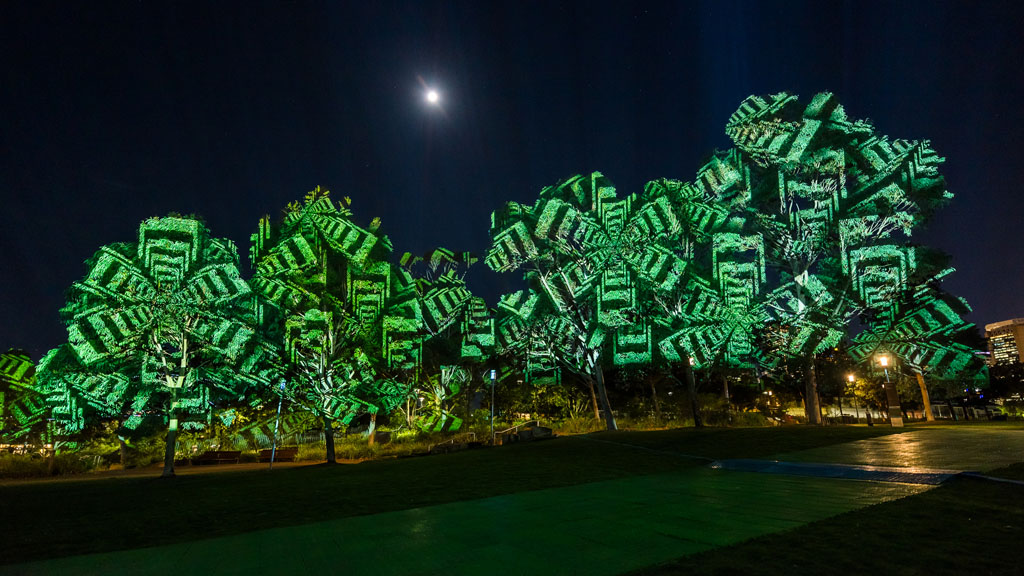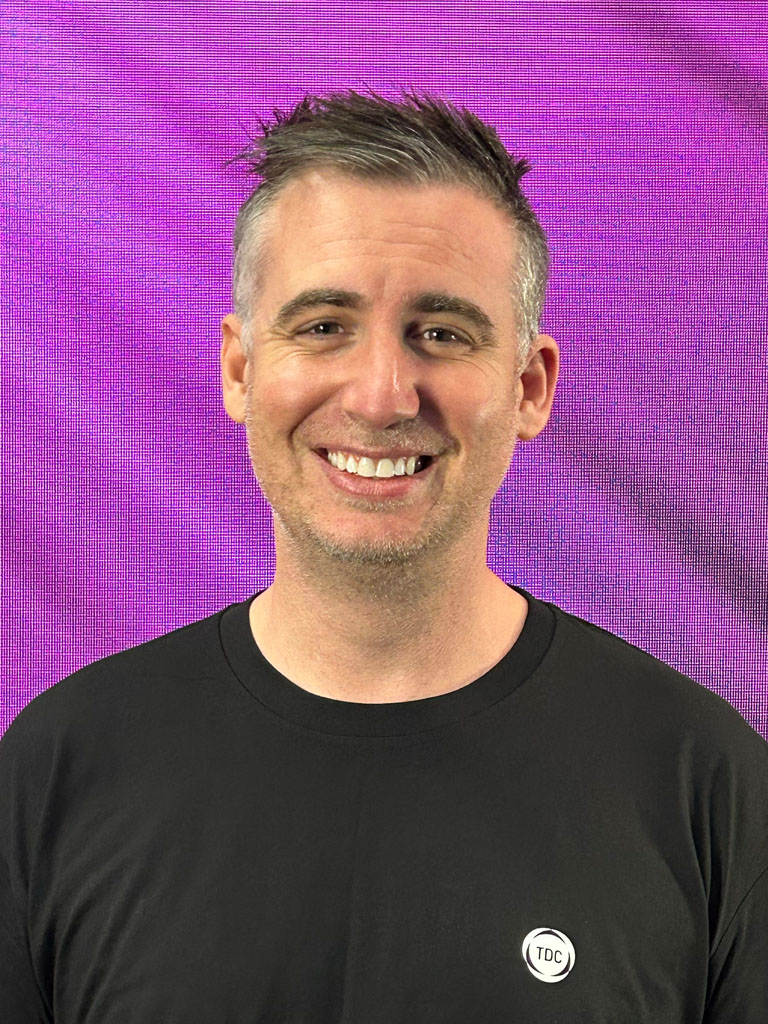VIVID AND BEYOND
Vivid Sydney lit up the Emerald City for the 14th time May 24 to 15 June, with the ‘Vivid Light’ quarter of the programme including 40km long lasers shooting from Sydney Tower, the spectacular Lighting of the Sails of the Opera House, and installations across, and even under, the city. TDC – Technical Direction Company have long provided their expert projection mapping services to the festival.
We spoke with Drew Ferors, Head of Technical Services at TDC, about how the company approach a festival on such an epic scale. “In 2024, there were 15 different installations that we were looking after with 90 projectors,” outlines Drew. “We’ve been improving our remote control and monitoring of the installations every year, creating our own software and adding capabilities like 4K resolution and fibre optic transport. We build robust systems that don’t need to be tended to by technicians day in, day out. Systems that are durable, able to run in the rain, and have backup systems in place.”
Starting years ago with simple remote ‘turn on and off’ capabilities, TDC’s remote systems are now more like NASA’s Mission Control. “Our ability to remotely control and monitor all of our projection installations makes our delivery robust,” explains Drew. “It makes it easier for us, and also the client. We have fitted all of the installations with PTZ security cameras with optical zoom that can look closely at parts of the buildings from a centralised location in the city. Rather than having technicians sitting in each individual projection tower, the main body of our technical staff are in a much more comfortable workspace at the Event Control Centre. They have a live camera feed of every single projection location that we’re doing at Vivid, all in the one spot. Our internet access to the installations has gotten a lot better, as Destination New South Wales have run hardwired internet to all of them. 4G is impractical, because when the city is full of people, it just slows right down.”
In previous years, each projection location was staffed, and adjusting the shows once they were up and running was a difficult matter. “Now, we perform a lineup tweak at the beginning of every single night, on every single installation,” continues Drew. “We’re also recording all of our activity. When the technicians are zooming in on a certain part of a building, we capture all of that, and we can then review it to see if there’s any sort of ongoing issue. If a certain projector is always drifting to the left, we can see that in the records, then go to the site and rectify it.”

As thousands pour into the city every night to see the shows, TDC’s techs are already at the Control Centre and have done their pre-show checks. “Before the show starts, we’re able to check all systems within 20 minutes, logging into each individual site to double check all the systems are perfect before the projectors have even sparked on,” boasts Drew. “We’re able to get ahead of any issues before they affect the show. We can log in, tweak projector lineups, lens shift, or refocus the projector from the Control Centre, or indeed anywhere in the world. The lineups of these projection installations always require a little bit of maintenance, which traditionally we would do once every three days at best.”

Even the monitoring software has its own monitoring software; “On top of site software that’s monitoring all of the projectors, we have a cloud-based software that’s monitoring that monitor, making sure that it’s operating correctly as well,” confirms Drew. “For example, it could be 11 am on a Monday, and I get an email from the system telling me we’ve lost power at Customs House. We can action staff to attend the site, and this is hours before the show. It’s fixing issues before they’re even an issue. It’s preventative rather than reactive and it really does help us sleep better at night. The amount of uptime of the projection installations is so much higher than it used to be, and we have records of all of it. We can share that confidence with the client and send them our central control view so they can see all of the projectors working for them at all times.”

An interesting outcome of switching to totally remote monitoring has been finding that it is in many ways superior to doing it on-site. “Monitoring cameras with optical zoom are good enough for us to line up the building projections remotely,” confirms Drew. “On-site, it’s quite difficult to focus your eye on the laptop in front of you and then focus up on the building 40 metres away. When you’re on a screen, and you’re sitting in the comfort of an office, you’re out of the cold, you’re not rushed, and you don’t want to get out of there quickly. When it comes to lining up the pixels of the projection, we can zoom right in, and we’ve discovered that we get better results using security cameras with optical zoom than the human eye.”
In terms of gear, TDC relied exclusively on Barco projectors to power Vivid, running the flagship UDM Series alongside the UDX Series. For media servers, installations varied multiple models of server from disguise and Christie’s Pandora’s Box.


I asked Drew which particular projection at Vivid he was most proud of; “My personal favourite was ‘Nest’ in Barangaroo,” he replies. “We created a big circular structure of TDC’s gostMESH product, which is a nano-technology fabric that absorbs colour and light while remaining transparent and invisible. We then projected beautiful imagery of slow-moving birds. It was visually stunning.”
Beyond Vivid
While the city-spanning Vivid gets most of the attention, TDC have been working to deliver immersive experiences on many other projects. One of them is Dream Circus at Sydney’s Lunar Park Big Top, a 45-minute immersive multimedia show that runs several times a day. Having seen UK company Hive’s modular media management system at ISE this year, I was pleased to find out that TDC have deployed the first installation of it in Australia.

“Having had a great experience with the flexibility of the servers we decided they would be a perfect solution for Luna Park. Hive occupies a good middle ground in the market. The really advanced media servers like disguise and Pandora’s Box are designed for highly experienced technicians to use. They’re designed for quick and easy changes to be made by professionals on-the-fly. Dream Circus is a permanent installation so limited changes to the output are required, so it doesn’t need that level of flexibility.”
“The Hive media player is really great at being able to reproduce shows the way a museum would run them,” continues Drew. “You upload the content and then repeat it more or less forever. Luna Park is a really robust system. Everything is timecoded together, and plays beautifully in sync. We don’t have technicians at Luna Park on a permanent basis; it’s all handled by the client. All they have to do is push a big ‘play’ button when all their audience members are seated. Hive is designed to have a user-friendly interface for the end-customer. We monitor that system remotely as well, with the same cameras and systems we use on Vivid.”

Dream Circus runs on 38 Barco G Series projectors that are fed media from 32 Hive Pluto Beeblade media engines, housed in Hive’s 5U Beehive chassis, sitting alongside 10 Hive Beebox media players.
The Hive infrastructure is housed in a central ground-level room, with fibre optic signal transport to the projectors. Each Hive media player is a stand-alone piece of hardware, so if there’s a failure, it won’t take out the whole system like a traditional media server would. You can simply take out the faulty unit, and slot in a replacement.


